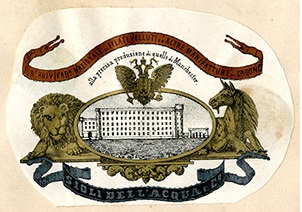- Milano
- “Mario Romani” Department of Economic and Social History and Geographical Sciences
- Archivio Visconti di Modrone
- I fondi
- Stabilimento Velluti Visconti di Modrone - Velvis
Stabilimento Velluti Visconti di Modrone - Velvis
1738-1983

It was Duke Raimondo Visconti di Modrone who started the family's textile business in 1865, taking over the Cotonificio Sioli Dell'Acqua & Co.in Vaprio d'Adda, auctioned by its last owner, Count Giuseppe Archinto. Under the direction of Raimondo, and later his brother Guido, the Vaprio plant became a company whose technical improvements and production innovations earned it a place at the forefront of Italian industry. In 1903 the management of the company passed to his grandson Uberto, who merged the Vaprio cotton mill with two other family businesses - the Tessitura Visconti di Modrone in San Vittore Olona, which had been operating since 1871, and the Candeggio Visconti di Modrone, founded in 1885 in Somma Lombardo - creating the Stabilimenti Visconti di Modrone. The company was dissolved in 1924, after the death of Uberto, then reborn as two different companies, the Società Anonima Tessitura e Candeggio Fratelli Visconti di Modrone (with two factories in San Vittore Olona and Somma Lombardo, respectively) and the Stabilimento Duca Visconti di Modrone di Marcello Visconti di Modrone in Vaprio d'Adda, known since 1954 as the Stabilimento Duca Visconti di Modrone Velvis. In 1986 the company became part of the Inghirami Group.
This section of the archive includes only a part of the documentation concerning the Visconti textile companies. In fact, in the family archive there are numerous files, registers and drawings that refer to the weaving and spinning businesses run by the family between the 19th and 20th centuries. Here, there are folders of documents, recovered by a former employee of the Velvis factory in 1991 and delivered to the Associazione Culturale Duca Marcello Visconti di Modrone, and 16 administrative registers.
Other documents relative to the Velvis factories can be found in the 19th-century collection organized by subject under the title Fondi e case - Vaprio d'Adda ed Uniti, and under the title Imprese industriali.
 All the documentation constituted a single nucleus, a sort of "industrial archive" which was later dismembered for administrative reasons. Due to the fragmented nature of the documentation, a list of dossiers rather than a proper inventory has been drawn up. The files mainly concern the acquisition and operation of buildings in Vaprio, the use of water for mills and industrial needs, the payment of salaries and various benefits to workers and clerks. Particularly interesting is the collection of articles and magazines and the preparatory material for a booklet celebrating the first centenary of the plant. For the iconographic material relating to the plant, see also the series of Maps and drawings.
All the documentation constituted a single nucleus, a sort of "industrial archive" which was later dismembered for administrative reasons. Due to the fragmented nature of the documentation, a list of dossiers rather than a proper inventory has been drawn up. The files mainly concern the acquisition and operation of buildings in Vaprio, the use of water for mills and industrial needs, the payment of salaries and various benefits to workers and clerks. Particularly interesting is the collection of articles and magazines and the preparatory material for a booklet celebrating the first centenary of the plant. For the iconographic material relating to the plant, see also the series of Maps and drawings.
“Mario Romani” Department of Economic and Social History and Geographical Sciences
- About us
- Research Projects
- Teachings A.Y. 2025/2026
- MASTER
- PhDs
- Department Publications
- Events
- Other Initiatives
- International Area
- Department Library
- Archivio per la Storia del movimento Sociale Cattolico in Italia «Mario Romani»
- Archivio Visconti di Modrone
- Associazione Duca Marcello Visconti di Modrone per la storia dell’industria
- I fondi
- Serie antiche
- Serie ottocentesche per materia
- Serie ottocentesche ad personam
- Famiglia Anguissola di Grazzano
- Famiglia Taverna
- Altre serie
- Opera Pia Visconti di Modrone
- Pio Istituto Teatrale di Milano
- Stabilimento Velluti Visconti di Modrone - Velvis
- Società anonima per l'esercizio dei Teatri alla Scala e Canobbiana
- Struttura del complesso
- Come accedere all'Archivio
